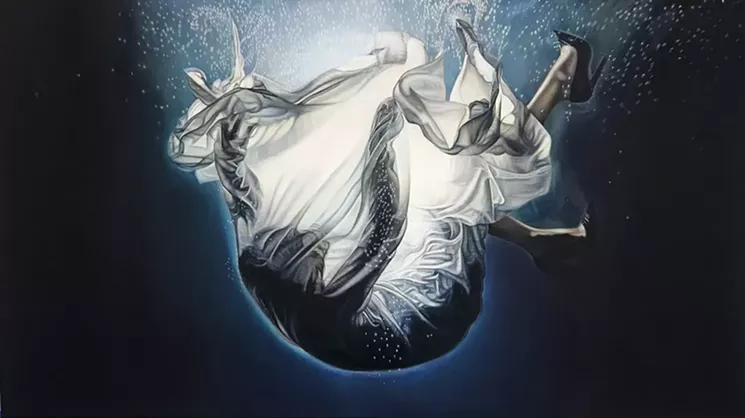They’re part of an installation by Antonia Wright, whose work pushes past the boundaries of traditional landscape art.
Her image appears on a video projected onto a giant two-sided screen at the center of the gallery. She’s walking across a vast expanse of ice, as if toward the viewer, wrapped in fire-colored silk clothing.
Wright’s installation reveals a central tenet of SMoCA’s newest exhibit: Women walk through the world with power and intention, shifting landscapes along the way.
Women’s voices have been vastly under-represented in art history, according to Jennifer McCabe, who curated the exhibition. But “Counter-Landscapes: Performative Actions from the 1970s-Now” flips that script.
Most of its artists are women, even though traditional art spaces continue to show far more works by men. “Women are often a footnote,” McCabe says. “Here, they are the most important part of the story.”

Ana Teresa Fernández, Of Bodies and Borders 1 (performance documentation), 2017, oil on canvas, 54 x 94 inches.
Ana Teresa Fernández and Gallery Wendi Norris
.
A monitor plays a video of the artist making the work. She’s wearing a black dress and stilettos. But she’s transformed the shoe into a paintbrush of sorts, dipping the toe in paint so it splatters when she dances the tango. Her shoes sit encased nearby.
It’s one of many works that reveal the ways women are using performance to challenge traditional ideas about what constitutes art, where it should happen, and who gets to participate.
“It generally doesn’t have as many rules,” McCabe says. “That opens up different ways of thinking about what art is and how it can be part of our lives.”
More than merely giving women artists a platform, McCabe highlights the ways they’re changing conversations about art by bringing art into everyday settings.
Four photographs lining a museum wall show various stages of planting and harvesting a wheat field. Agnes Denes planted the wheat atop a landfill near the financial district in New York in summer 1982, in part to address economic disparity and environmental issues.
Landscapes are ubiquitous in the art world, of course. Museum walls are filled with paintings by Thomas Cole, Claude Monet, and countless others. Often, they capture moments in time and space, channeling a desire to keep the view as it is.

Marina Abramovic, Looking at the Mountains from the series Back to Simplicity, 2010. Colour pigment print, 160x 200 cm (print), 63 x 78.7 in print. Copyright Marina Abramovic.
Lisson Gallery
Instead of objects for passive consumption, art becomes an experience. And it grows more accessible because it’s happening in urban and natural settings outside the confines of an exhibition space.
Tempe artist Angela Ellsworth and her partner walked a 20-mile half-circle from a Phoenix gallery to the Mormon temple in Mesa back in 2006, then completed the circle as part of “Counter-Landscapes.”
The map for their journey reads “The Ellsworth and Katan Trail,” referencing the Mormon Trail walked by
Ellsworth’s ancestors. It’s displayed at the museum, along with the black-and-red fringed outfits they wore making the walk all those years ago.
“Counter-Landscapes” goes far beyond flipping the script. It encourages those who explore the museum to be more active in transforming their own individual and community landscapes.
"Counter-Landscapes: Performative Actions from the 1970s-Now” continues through January 19, 2020, at Scottsdale Museum of Contemporary Art. Museum admission is $10. Visit smoca.org.












